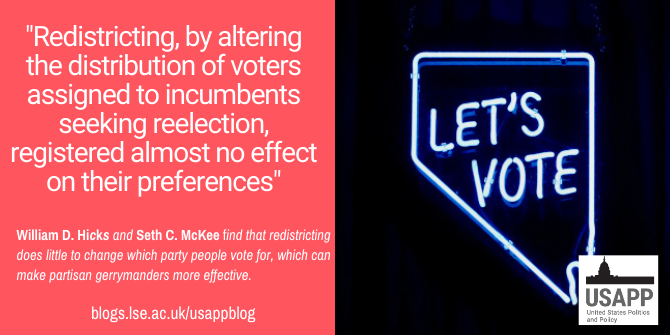
 Every decade US state legislators redistrict the congressional districts in their state based on new census information. Over the decades redistricting has become another means by which a political party can gain electoral advantage. In new research using Pennsylvania’s redistricting as a case study, William D. Hicks and Seth C. McKee find that voters in redrawn districts did not change their voting preferences, and that changes in their incumbent candidate or an electoral tide towards the Democratic Party had little or no effect on these choices.
Every decade US state legislators redistrict the congressional districts in their state based on new census information. Over the decades redistricting has become another means by which a political party can gain electoral advantage. In new research using Pennsylvania’s redistricting as a case study, William D. Hicks and Seth C. McKee find that voters in redrawn districts did not change their voting preferences, and that changes in their incumbent candidate or an electoral tide towards the Democratic Party had little or no effect on these choices.
Redistricting will always be a foreboding proposition for those already in office (known as incumbents), but its effects have changed considerably in recent US House elections. In the context of American politics, the redrawing of district boundaries is mainly carried out by partisan lawmakers. Specifically, in congressional elections, though more states are moving toward redistricting commissions (which are purportedly less partisan) tasked with producing the US House map, most states rely on partisan state legislators to draw their US House districts. In the latter scenario, it can be vitally important for the electoral future of an incumbent to share the party affiliation of the mapmakers.
For example, if the incumbent is a Democrat in a state where Democratic legislators control congressional redistricting, all things constant, this co-partisan incumbent will be treated kinder than their Republican incumbent colleague(s) (we are of course assuming the US House delegation in this state contains both major-party incumbents). This more favorable co-partisan treatment is a reality of long-term political changes that have produced growing partisan polarization and increasingly competitive national outcomes for Congress and the Presidency. With partisan control potentially flipping in these federal contests in any given election cycle, redistricting is an important political tool for either enhancing partisan advantage or limiting the possible partisan gains of the political opposition.
Greater partisanship means less split ticket voting and a falling incumbency advantage
Against the backdrop of a markedly more polarized United States in the 2020s than perhaps any time since the late 1800s, the voting behavior of the American electorate has become increasingly loyal along partisan lines and consequently, decidedly more predictable. Indeed, going back to 1952, in 2020 the American National Election Studies (ANES) recorded its highest percentage of strong partisans, at 44 percent, which was by 22 percentage points the most prevalent group in the American electorate (22 percent weak partisans, 22 percent leaning independents, and 12 percent independents). Additionally, 44 percent was the highest plurality for any of these groups spanning the ANES time series. In contrast, around the height of American partisan dealignment in 1978, the ANES data showed the distribution of the American electorate as 37 percent weak partisans, 24 percent leaning independents, 23 percent strong partisans, and 16 percent independents.
With a resurgence of strong partisans, at the same time there has naturally followed a decline in the share of voters splitting their tickets in presidential and congressional elections. For instance, not even controlling for partisanship, the ANES data show that in 1980 fully 28 percent of the electorate split their tickets for President and Congress, whereas in 2020 only 11 percent of voters did the same. These documented changes to the American electorate are evidence of nationalization, which in this specific case refers to the increasing alignment of partisanship with voting behavior, and particularly with presidential politics setting the stage for uniformity in partisan voting from the top to the bottom of the ballot.
Nationalization has reduced the power of incumbency because fewer voters now cross party lines to support incumbents from the ‘other’ party in congressional elections. Computed as a share of the vote incumbents receive by virtue of being the officeholder, according to University of California San Diego political scientist, Gary Jacobson, twenty years ago (in 2000) the incumbency advantage was worth 8.6 percentage points. In 2020, the incumbency advantage registered an all-time low of 1.6 percentage points. In the 2018 midterm elections, Jacobson omitted Pennsylvania from his measure of the incumbency advantage because the state redrew its congressional districts.

Photo by Manny Becerra on Unsplash
Using Pennsylvania to understand the effects of redistricting on vote choice
In new research we examined what effects, if any, did redistricting have on Pennsylvanians’ voting behavior in the 2018 US House elections. Based on the data we have discussed so far, we strongly expected that even in an election cycle when a Republican President had a 40-seat midterm House loss, the massive redistribution of voters into different Pennsylvania congressional districts likely had minimal effects on vote choice.
From 2012 to 2016, Pennsylvania conducted its congressional elections under a map heavily gerrymandered in favor of Republicans. In fact, despite losing a seat through reapportionment (going from 19 to 18 districts), a 12 Republican/7 Democrat delegation in 2010 became a 13 Republican/5 Democrat delegation in 2012! This 13/5 split favoring Republicans held until a March 2018 special election (still under the Republican-drawn map) yielded a Democratic victory for Conor Lamb in what was at the time District 18. Prior to the 2018 general elections, the Pennsylvania Supreme Court redrew the congressional boundaries. Of the eleven districts with incumbents seeking reelection in 2018, 31 percent of constituents were placed in a district with an incumbent who did not represent them before redistricting. We call these voters Redrawn based on being placed in a district with a different incumbent running for another term. Under the altered congressional map, Democratic Representative Lamb ran against a fellow incumbent, Republican Keith Rothfus in the reconfigured District 17. Lamb won even though almost 80 percent of his constituents were Redrawn, versus 44 percent Redrawn constituents for Rothfus. This dueling incumbent contest removed one Republican from office and Pennsylvania Democrats netted two more wins in open seats. Thus, a 12/6 Republican delegation before the midterm was now a 9/9 evenly split partisan delegation after the elections.
We emphasize the status of Redrawn constituents because previous research demonstrates a greater likelihood of their voting behavior being less stable. Simply put, these voters have little to no familiarity with the incumbent in whose district they now reside, due solely to a boundary change. Under this condition, with all other things being equal, we would expect that Redrawn voters therefore are less likely to vote for the incumbent compared to voters the incumbent retains after redistricting. That is, of what incumbency advantage there is, it should be greatly discounted among Redrawn voters because incumbents have not solidified a representational relationship with these constituents. Also, if the election takes place during a partisan tide in which political conditions favor one party, then Redrawn constituents should be more susceptible to voting in the direction of the tide. Of course, the 2018 midterm US House elections occurred during a cycle when the partisan tide clearly moved in favor of Democrats.
Pennsylvania in the 2018 midterm congressional elections is an intriguing case to assess whether Redrawn voting behavior exhibited notable movement because political conditions advantaged Democrats while the incumbency advantage had dwindled to a few percentage points in an era of nationalization. With comprehensive precinct data and individual-level survey data on a sample of Pennsylvanians, in line with expectations, we find redistricting exhibited either minimal or zero effects on voter preferences in the 2018 midterm US House elections. Our strongest finding comes from a precinct analysis, which shows that controlling for several factors, Redrawn precincts awarded Democratic incumbents about a 2-percentage point higher share of the vote. This dynamic offers some modest support for the expectation that a Democratic tide moves Redrawn voters in favor of Democratic candidates. Nevertheless, after interacting the party of the incumbent with whether a voter is Redrawn (survey data), we find no statistically significant effect on the partisan vote in the district.
Redistricting has nearly no effect on voter’s preferences
Our data on Pennsylvania in 2018 offer robust support for the claim that redistricting, by altering the distribution of voters assigned to incumbents seeking reelection, registered almost no effect on their preferences. Instead, there is a much simpler explanation for why Democrats in Pennsylvania picked up three US House seats in 2018. Based on the partisan distribution of the 2016 presidential vote in Pennsylvania’s congressional districts, the new House map was made more favorable to Democrats. In other words, the Republican-drawn gerrymander that was in place from 2012 to 2016 was replaced with district boundaries comparably more hospitable to Democrats and this is evident by looking at the changed distribution of the 2016 Democratic presidential vote in the 2018 districts. So, instead of many Redrawn voters changing their preferences due to favorable short-term conditions shifting in the Democratic direction; or Redrawn voters being influenced by the presence of a different incumbent; it was instead the allocation of more Democratic voters into a handful of districts that were previously more Republican that primarily explains Pennsylvania Democrats’ US House gains in 2018.
Our findings from Pennsylvania offer a clear conclusion and pressing relevance, as the next round of congressional redistricting has commenced in most states. Because of nationalization, and with it a marked decline in the incumbency advantage, line drawers can have much more certainty that their maps will register their preferred election outcomes. Indeed, at no time in American history has the partisan composition and distribution of the electorate been such an overwhelming principal determinant of winners and losers. This means that in states where one party controls redistricting, partisan gerrymanders will be more successful than ever. To be sure, lawsuits will pile up and numerous state courts will determine whether partisan gerrymandering is justiciable and remediable (e.g., like Pennsylvania in 2018), because the US Supreme Court as recently as 2019 affirmed its position that partisan gerrymandering is a thicket they will stay out of.
- This article is based on the paper, ‘Pennsylvania in 2018: How Redistricting Does and Doesn’t Make a Difference’ in State and Local Government Review
Please read our comments policy before commenting
Note: This article gives the views of the authors, and not the position of USAPP– American Politics and Policy, nor of the London School of Economics.
Shortened URL for this post: https://bit.ly/3FamrKL
About the authors
 William D. Hicks – Appalachian State University
William D. Hicks – Appalachian State University
William D. Hicks is an associate professor of Political Science at Appalachian State University. His research focuses on American political institutions, elections and election laws, criminal justice policy, and quantitative methodology.
 Seth C. McKee – Oklahoma State University
Seth C. McKee – Oklahoma State University
Seth C. McKee is a professor of Political Science at Oklahoma State University. His research focuses on American electoral politics, political behavior, and party system change.






